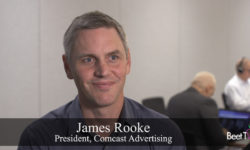If a tree falls in a forest but no-one is around to hear it, did it make a sound?
It is a classic philosophical poser that is now being applied to connected TV advertising.
In this video interview with Beet.TV, Adam Gerber, executive director of U.S. investment strategy at GroupM, calls on publishers to stop counting ad views that happen when a viewer’s TV is switched off.
Is this thing on?
The problem, for advertisers, of content and ads continuing to stream to viewers’ dongles, boxes or sticks even when the viewing device, the TV, has been turned off, is just one of the bottlenecks GroupM is now becoming increasingly public about.
It follows a joint study with TV ad measurement company iSpot that quantifies inflated CTV ad delivery counts. It revealed that, on average, 8-10% of streaming impressions play when the TV is shut off, primarily through ancillary devices.
“The MRC (Media Ratings Council), as far back as 2018, had initially put in place language in their impression guidelines that referred to the TV on-off problem,” Gerber says.
There wasn’t a commitment by the industry to solve it. We need to do much better. We need to work much faster.
Pushing for tech
GroupM is calling the phenomenon “continuous play”.
Gerber says: “There’s no good clarity right now in the industry for hardware to be talking to each other. There are literally tens of thousands of different permutations of those combinations of TVs and devices and apps.”
GroupM last year called on more publishers to implement “Are You Still Watching?” end cards designed to prompt users to confirm they are still present. The agency says many have implemented it, but it is not a solution in its own right.
This summer, it announced that “companies including Disney, Fox/Tubi, LG Ads Solutions, NBCUniversal, Paramount, VIZIO and Warner Bros. Discovery have committed to working at an industry level with agencies, advertisers, and standards-setting bodies” on a measurement framework that ensures ads are only counted when delivered to screens known to be on that have viewers in front of them.
Call to publishers
Gerber was a speaker at the Advanced Advertising Summit in New York. He was interviewed by Jon Watts, Editorial Director, Beet.TV Events.
But the “continuous play” issue is just one of the challenges he says the buy side faces when it comes to connected TV. Gerber also wants better features to reduce duplicate ad exposure.
“If I know that I’ve delivered a household or a viewer on a, through a streaming service in the past 24 hours, I should be able to not deliver that person anywhere else,” he complains.
Gerber is frustrated that those features apparently don’t exist.
“The different media companies that I operate with don’t really want, or haven’t enabled, the ability for me to manage frequency at a campaign level, as opposed to within individual silos,” he says.
“We are starting to talk about these problems publicly. We believe they need to be solved. We want to work collaboratively with the industry to solve them.”





































